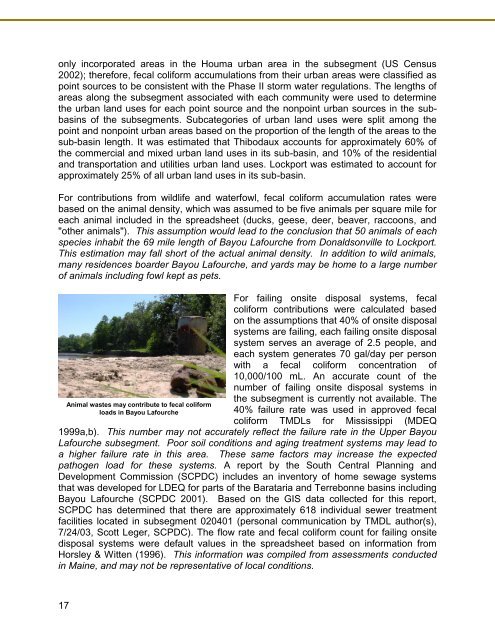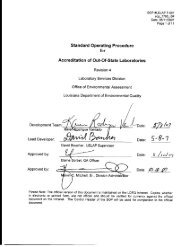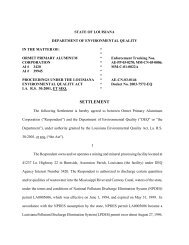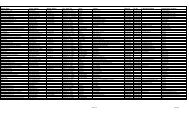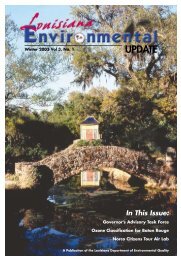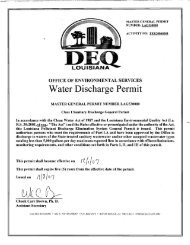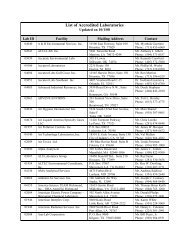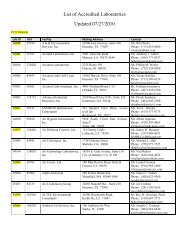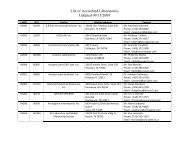Bayou Lafourche
Bayou Lafourche - LDEQ Nonpoint 319 Projects
Bayou Lafourche - LDEQ Nonpoint 319 Projects
- No tags were found...
Create successful ePaper yourself
Turn your PDF publications into a flip-book with our unique Google optimized e-Paper software.
only incorporated areas in the Houma urban area in the subsegment (US Census<br />
2002); therefore, fecal coliform accumulations from their urban areas were classified as<br />
point sources to be consistent with the Phase II storm water regulations. The lengths of<br />
areas along the subsegment associated with each community were used to determine<br />
the urban land uses for each point source and the nonpoint urban sources in the subbasins<br />
of the subsegments. Subcategories of urban land uses were split among the<br />
point and nonpoint urban areas based on the proportion of the length of the areas to the<br />
sub-basin length. It was estimated that Thibodaux accounts for approximately 60% of<br />
the commercial and mixed urban land uses in its sub-basin, and 10% of the residential<br />
and transportation and utilities urban land uses. Lockport was estimated to account for<br />
approximately 25% of all urban land uses in its sub-basin.<br />
For contributions from wildlife and waterfowl, fecal coliform accumulation rates were<br />
based on the animal density, which was assumed to be five animals per square mile for<br />
each animal included in the spreadsheet (ducks, geese, deer, beaver, raccoons, and<br />
"other animals"). This assumption would lead to the conclusion that 50 animals of each<br />
species inhabit the 69 mile length of <strong>Bayou</strong> <strong>Lafourche</strong> from Donaldsonville to Lockport.<br />
This estimation may fall short of the actual animal density. In addition to wild animals,<br />
many residences boarder <strong>Bayou</strong> <strong>Lafourche</strong>, and yards may be home to a large number<br />
of animals including fowl kept as pets.<br />
For failing onsite disposal systems, fecal<br />
coliform contributions were calculated based<br />
on the assumptions that 40% of onsite disposal<br />
systems are failing, each failing onsite disposal<br />
system serves an average of 2.5 people, and<br />
each system generates 70 gal/day per person<br />
with a fecal coliform concentration of<br />
10,000/100 mL. An accurate count of the<br />
number of failing onsite disposal systems in<br />
the subsegment is currently not available. The<br />
Animal wastes may contribute to fecal coliform<br />
loads in <strong>Bayou</strong> <strong>Lafourche</strong><br />
40% failure rate was used in approved fecal<br />
coliform TMDLs for Mississippi (MDEQ<br />
1999a,b). This number may not accurately reflect the failure rate in the Upper <strong>Bayou</strong><br />
<strong>Lafourche</strong> subsegment. Poor soil conditions and aging treatment systems may lead to<br />
a higher failure rate in this area. These same factors may increase the expected<br />
pathogen load for these systems. A report by the South Central Planning and<br />
Development Commission (SCPDC) includes an inventory of home sewage systems<br />
that was developed for LDEQ for parts of the Barataria and Terrebonne basins including<br />
<strong>Bayou</strong> <strong>Lafourche</strong> (SCPDC 2001). Based on the GIS data collected for this report,<br />
SCPDC has determined that there are approximately 618 individual sewer treatment<br />
facilities located in subsegment 020401 (personal communication by TMDL author(s),<br />
7/24/03, Scott Leger, SCPDC). The flow rate and fecal coliform count for failing onsite<br />
disposal systems were default values in the spreadsheet based on information from<br />
Horsley & Witten (1996). This information was compiled from assessments conducted<br />
in Maine, and may not be representative of local conditions.<br />
17


